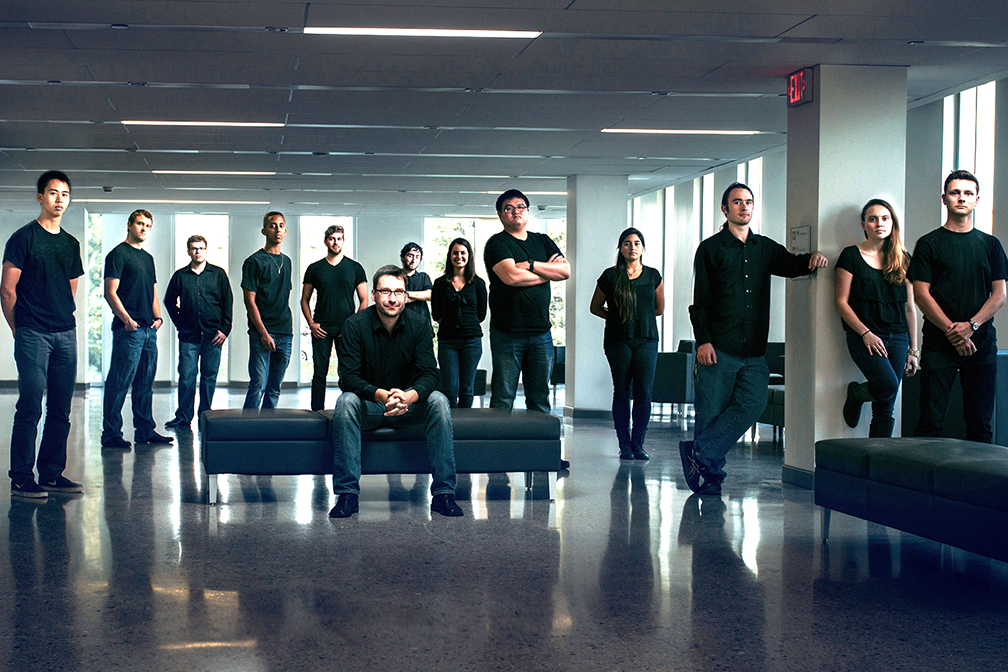New Creative Technologies in Music Degree Option Reimagines Instruments and Soundmaking
May 4, 2018

Zip. Whoosh. Zip. Zip. These are the sounds of a needle moving in a vinyl record’s groove while someone moves a turntable back and forth. With a closer listen, the sounds transform into a melodic, rhythmic moment — or an evolving musical instrument.
Record scratching — along with Virginia Tech’s distinctive Linux Laptop Orchestra, multimedia soundscapes forged in the Cube, and new ways to notate music arrangements through self-scrolling spreadsheets — are part of a unique direction of study at Virginia Tech, with the development of a new creative technologies in music option through the bachelor’s degree in music.
This innovative area of study, inspired by emerging digital technology and unrestricted methods of soundmaking, is as competitive and rigorous as traditional music programs. Yet it also provides undergraduates the opportunity to explore musical applications involving engineering, the visual arts, theatre, and cinema.
The foundation of the creative technologies in music program, one of the first of its kind to receive accreditation through the National Association of Schools of Music, is electroacoustic — using electronics to create music, whether by creating new instruments, composing music, researching sound, or using a combination of these in performances. Students can choose to pursue electroacoustic composition, research, or both.
“The students who want to enter on the composition side are the ones who understand the concept of computer or electronic music,” said Ivica Ico Bukvic, an associate professor in creative technologies in music at the Virginia Tech School of Performing Arts. “They think about becoming DJs or turntable artists, using instruments that aren’t represented in traditional music programs and yet offer incredible levels of musicianship and virtuosity. We’re trying to catch those awesome, creative students who haven’t yet found their niche.”
Bukvic leads the program along with two of his School of Performing Arts colleagues, Eric Lyon, an associate professor of music technology and composition, and Charles Nichols, an assistant professor of composition and creative technologies.
“Our initiative is to build the creative technologies and composition areas into world-class programs,” Nichols said. “I compose locally to present my pieces globally, and I encourage my students to do the same. I’ve had students present their music at national and international conferences and festivals, such as a film-scoring workshop at New York University, the Charlotte New Music Festival, and International Computer Music Conferences in Australia and Slovenia.”
During the audition process, students have the option of bringing in their own instruments and performing a re-conceptualized, self-created arrangement that highlights their instrument’s uniqueness.
For students interested in research, entry into the program involves presenting a self-created tool — often for phones, tablets, or computers — that shows a larger potential that the degree option would help enhance. Research could focus on such topics as sound properties, acoustics, spatial sound, sonification, or the human perception of sound, as long as it is centered on sound or music.
“The creative technologies field gives me the perspective to use technology for creative pursuits through composition, such as how to create music algorithmically, and it teaches me problem-solving in the computer science field,” said Galina Belolipetski, a senior from Rockville, Maryland, who is majoring in computer science, music composition, and creative technologies in music.
“It’s a fantastic field for collaborative work,” Belolipetski added. “I’ve worked with individuals who study engineering, psychology, computer science, and cinema, and I hope to continue to work in fields like theatre and science.”
The genesis of the degree option began a decade ago, when Bukvic conceived a plan and began working toward accreditation. To help with the process, in 2007, he founded and now directs the Digital Interactive Sound and Intermedia Studio (DISIS), which involves music as a catalyst to bring different majors together.
Through DISIS, housed in Newman Library, Bukvic discovered that the interdisciplinary nature of the studio appealed to more than traditional music majors. Many of the students’ projects engage in real-world applications, such as collaborations with NASA and research funded by the National Science Foundation.
Through the studio’s successes, Bukvic and his colleagues hope to recruit students who want to push the boundaries of music and sound.
“With this program, you explore a range of artistic endeavors,” he said. “You never feel you’re overstepping your bounds. You chase that unrestrained creativity that makes you feel passionate and brings out the best in you.”
Several students who have taken related courses before creative technologies in music became available as a degree option have spoken to the classes’ success in helping them achieve a range of careers. These graduates now work in Fortune 500 companies, have become computer programmers, or have enrolled in graduate school.
“We want students to graduate empowered with a skillset of self-sufficiency, confidence, and curiosity,” Bukvic said. “The world is theirs. No matter what they do, they will succeed, and that’s the most important message this degree option bestows on students.”
Written by Leslie King





